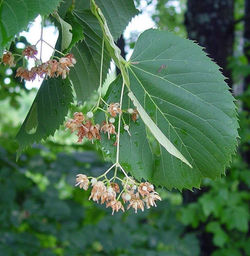Nature Park
The Museum offers a 45-acre Nature Park with both short and long trails open for exploration. There are guided and self-guided tours. In the Nature Park visitors are introduced to the Iroquois view of nature -- Our Mother the Earth, our Elder Brother the Sun, our Grandfathers the Thunderers, our Three Sisters (Corn, Beans, and Squash), the earth as Turtle Island, the nine clan animals, the four beings who are the winds, our Grandmother Moon, Morning Star, the Seven Dancers, and the medicines and herbs gifted by the Creator.
The Park consists of fields and woods, with a feeder stream winding its way down to Cobleskill Creek, which flows along the entire southeast corner of the park. Sometime in the last century, a huge stone dam was built across the stream, but one of those "once in a century" storms took out the center of the dam, leaving mute but dramatic testimony to the power of the surrounding watershed. Today the stream is classified as a trout stream by DEC, but trout have yet to be discovered. Other fish, frogs, crayfish, green heron, kingfisher, and a rare visiting beaver have been noted.
The park is a fine spot for birding. Deer and racoon are plentiful, as though the site has become an island of safety for them. The woods has a strong group of shagbark hickory trees, with many venerable and stately hemlocks. A few dignified maples are engaged in their silent struggle against "Maple Decline," and the Park's many ash trees are trying desperately to survive the spread of the Emerald Ash Borer.
In the Nature Park are two 19th century log homes moved from Six Nations Reserve, Ontario, and rebuilt by a Mohawk construction company. The homes were used as residences well into this century.
 Basswood |
|---|
 Maple |
|---|
 Sumac |
|---|
 Bloodroot |
|---|
 Sassafras |
|---|
 Hickory |
|---|
 White Pine |
|---|

Species name: Fagus grandifolia Mohawk name: Otskèn:rha Beechnuts were roasted and eaten by early Haudenosaunee and boiled to extract highly prized oils for seasoning. Both the tree’s nuts and inner bark were ground into flour. Its tender spring leaves were steamed as greens. The beech is used in blood purifiers and to treat tuberculosis, jaundice, and burns. Bowls and pothooks are often made from beech wood.

Species name: Fraxinus nigra Oneida name: Kahuwe yá Black ash is ideal for making baskets, which have practical uses and are also valued for their artistic possibilities. The black ash tree is currently threatened by the invasive emerald ash borer, a green beetle native to Asia that has the potential to drive the North American ash tree into extinction. This would put an end to centuries of black ash splint basketry by the Haudenosaunee.

Species name: Prunus serotina Mohawk name: Erihkó:wa Haudenosaunee eat the fruits of this tree, but its pits are poisonous. Cherries are used to treat colds, headaches, fevers, tuberculosis, cuts, soreness, and coughs. Black cherries are also used as a blood purifier.

Species Name: Ostrya virginiana Seneca name: Gasnö:në’ The wood of hop hornbeam is hard and durable making it useful for fence posts, tool handles, and fuel. These qualities also make it prized for the javelin-like snow snakes used in a competitive winter game played by Haudenosaunee men. The bark and inner wood was used to treat the cough associated with post nasal drip.

Species name: Arisaema triphyllum Mohawk Name: Nikahrhonsherà:’a This common eastern woodland plant is named after the uncommon shape of the plant’s flower. The identifying feature of a Jack-in-the-pulpit flower is the pouch-shaped structure and overhanging hood (“pulpit”) that covers a fleshy spike central spike (“Jack”). In the past, the Haudenosaunee pounded dried Jack-in-the-pulpit root to produce a powder to be used in soups and stews. Jack-in-the-pulpit was also used as a medicine ca

Species name: Asclepias In the past, the stems and leaves of young milkweed plants and the bud clusters of older milkweed plants were used as a food source for the Iroquois. Milkweed was also used to treat gout, parasites, diabetes, and headaches.

Species name: Toxicodendron radicans Onondaga name: Ko hoon’tas This 3-leafed plant causes itching and skin eruptions soon after contact with its sap. Historically Haudenosaunee managed its blisters with jewelweed and the boiled knots of white pine. Despite its unfavorable reputation, the berries serve as an important food source for wildlife. Today, Haudenosaunee occasionally make a topical paste from this plant to treat sores that are difficult to heal.

Species name: Symplocarpus foetidus Mohawk Name: Tsorà:kare Skunk cabbage is a plant that gets its name from the unpleasant odor it releases. In its raw form, skunk cabbage contains high levels of calcium oxalate that in small doses (just one or two bites) causes burning and swelling of the mouth and a choking sensation. Heat breaks down the dangerous compounds of the raw plant. In the past, the Haudenosaunee used the boiled and powdered skunk cabbage to treat a variety of ailments. As a food, t

Species name: Trillium erectum Mohawk name: Tsona’tsì:’a Large-flowered trillium can be a rare site in the spring forest and is known for its edible and medicinal properties. It has been used medicinally for rheumatism, earache, birth control, as a painkiller, for headaches and as a suntan oil. The berries and roots are inedible.

Species name: Geranium maculatum Seneca name: ojisdahgwad Wild geranium is considered an astringent, a substance that causes contraction of the tissues and stops bleeding. Wild geranium was used by the Haudenosaunee to treat mouth sores, sore throats, diarrhea and venereal diseases.



